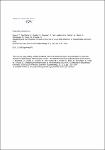Shedding and Transmission of Novel Influenza Virus A/H1N1 Infection in Households—Germany, 2009
Süß, Thorsten
Buchholz, Udo
Dupke, Susann
Grunow, Roland
Heiden, Matthias an der
Heider, Alla
Biere, Barbara
Schweiger, Brunhilde
Haas, Walter
Krause, Gérard
Essential epidemiologic and virologic parameters must be measured to provide evidence for policy/public health recommendations and mathematical modeling concerning novel influenza A/H1N1 virus (NIV) infections. Therefore, from April through August of 2009, the authors collected nasopharyngeal specimens and information on antiviral medication and symptoms from households with NIV infection on a daily basis in Germany. Specimens were analyzed quantitatively by using reverse transcriptase-polymerase chain reaction. In 36 households with 83 household contacts, 15 household contacts became laboratory-confirmed secondary cases of NIV. Among 47 contacts without antiviral prophylaxis, 12 became cases (secondary attack rate of 26%), and 1 (8%) of these was asymptomatic. The mean and median serial interval were 2.6 and 3 days, respectively (range: 1-3 days). On average, the authors detected viral RNA copies for 6.6 illness days (treated in time = 5.7 days, not treated in time = 7.1 days; P = 0.06), but they estimated that most patients cease to excrete viable virus by the fifth illness day. Shedding profiles were consistent with the number and severity of symptoms. Compared with other nasopharyngeal specimen types, nasal wash was the most sensitive. These results support the notion that epidemiologic and virologic characteristics of NIV are in many aspects similar to those of seasonal influenza.
No license information

